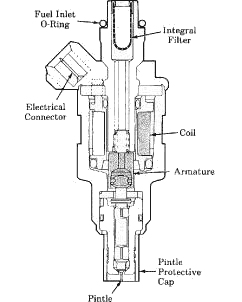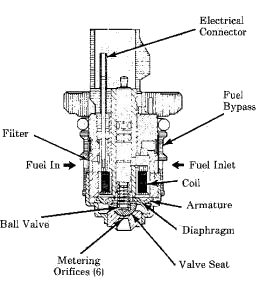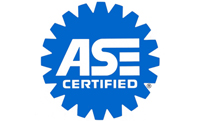Fixing Your
Present Vehicle Saves Money
Is it better to clean or replace
dirty fuel injectors
 
Injector Operation
Injectors include a precision-ground needle valve and are
controlled by an electro-magnetic solenoid that is turned on
and off by an electric control unit. Fuel is injected only
during the "on" time and is metered by the size of the
opening, duration of "on" time, and fuel pressure.
Injector Service
Try cleaning them first. If this is not successful, they
must be replaced.
Because of their construction, fuel injectors tend to "gum
up" after 15,000 to 30,000 miles of driving. Fuel spraying
from the injector must pass through a very small opening in
the discharge nozzle. This is necessary to create a
cone-shaped spray pattern that breaks the fuel up into a
fine mist for proper atomization.
Some newer style injectors are more clog resistant than
their predecessors, but all are vulnerable to some extent.
Every time the injector sprays fuel, a small amount remains
in the nozzle. As it evaporates, it leaves behind a wax-like
residue that forms hard varnish deposits.
The rate at which deposits build up depends on the quality
of gasoline burned, whether or not the gas has detergent in
it (and what kind), and the number of thermal cycles the
engine experiences per miles driven. Short-trip driving
builds up deposits more quickly than continuous driving.
As deposits build up in injectors, they restrict the
discharge orifice and break up the normal cone-shaped spray
pattern. The spray pattern may develop "legs" (streamers of
unatomized fuel) or turn into a continuous stream of
unatomized fuel like a fire hose.
Liquid fuel does not burn as efficiently as atomized fuel,
so it has a "leaning effect" on the air/fuel mixture.
Accumulated deposits in the discharge orifice also restrict
the total amount of fuel delivered per squirt, which further
compounds the leaning effect. This can result in the
appearance of driveability problems such as hard starting,
hesitation, poor fuel economy, loss of power, and elevated
exhaust emissions.
An engine with dirty injectors will usually show a wide
variation in RPM between cylinders when doing a power
balance test. There will also be a lot of variation in peak
firing voltages between cylinders on a scope.
For do-it-yourselfers, there are two options - use a fuel
additive to clean the injectors, or buy a can of pressurized
solvent that's designed for on-car injector cleaning. Fuel
additives can only do so much, so badly-clogged injectors
usually need to be pressure flushed with solvent.
With on-car cleaning, pressurized solvent is run through
injectors to flush out deposits. To do this, the fuel pump
is temporarily disconnected so solvent can be fed directly
into the test valve fitting on the fuel rail.
When the engine is started, the solvent becomes the
temporary "fuel supply" while injectors are cleaned.
The resulting improvement in performance is usually quite
noticeable. But on-car cleaning doesn't always do the trick,
especially if an injector is badly plugged.
Unless injectors are removed and tested, there is no easy
way to spot marginal injectors (those with defective spray
patterns) or ones that don't deliver as much fuel as the
others (mismatched injectors can reduce horsepower and
increase emissions).
Off-car cleaning involves more work, but results are often
worth it. For one thing, injectors that don't respond to
on-car cleaning can often be restored to like-new
performance with off-car cleaning.
Some available cleaning equipment can reverse flush
injectors, doing a thorough cleaning job. Most off-car
cleaning equipment also allows the mechanic to observe and
measure injector flow patterns so bad ones can be
identified.
Flow rating also allows injectors to be more closely matched
for improved engine performance
OneStop Auto Shop
Call Today for
all of your Auto Repairs
and Maintenance
in Hollywood, Ca.!
(323) 227-9999
|
























